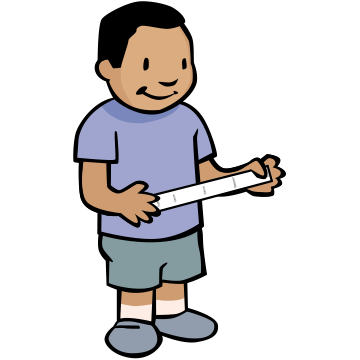Boston Children's Museum
308 Congress Street, Boston, MA 02210
617-426-6500
© Boston Children’s Museum 2025
Website Design by JackrabbitOur solar system is truly enormous. Developing a sense of just how enormous is difficult for almost anyone, let alone children. A good starting point to understanding how vast the universe is, is to have children explore the relative distances across our solar system, and this activity provides a fun first step in that understanding. This is also a great activity for learning about the major bodies in our solar system, and to practice measuring, estimation and fractions.
Cut strips of the adding machine tape or toilet paper to lengths of about 3 feet/1 meter. The strips should be no taller than your shortest student. NOTE: For a simpler version of this activity, which requires more physical space, but fewer materials, try the team-based Solar System Showcase activity from this curriculum. This game is also a good alternative for younger students.

Ask your students if they can name objects in our solar system. Keep a running list. Can they place them in order? How far apart do they think these objects might be? List out the major objects in our solar system, in order, on a piece of chart paper or chalkboard:
If you can, show your students the NASA images of some of these objects included with this curriculum. You can print them out or show them the images on a computer. You can also visit NASA’s amazing solar system website, which is full of images, information and more: http://solarsystem.nasa.gov/planets
Make a map of the solar system that you can keep!
This is a highly staff-directed activity, so you will lead each child through the steps. Distribute a strip of paper and a pen or pencil to each child, and walk them through these steps to create their solar system map:

Let’s Talk About It:
Ask your students if they were surprised by the results. It is worth reinforcing the vast distances between objects in our solar system – while it may look like they are close together, based on this activity, our solar system is a truly enormous place. Ask your students how long they think it might take to drive in a car, at 60 miles per hour, from Earth to Mars (using the average distance between the two). Write everyone’s guesses down on a piece of chart paper, dry erase board, etc. Did anyone come close? Reveal the answer (below), along with travel times to the Sun and the Moon:
Keep in mind this is non-stop travel. No bathroom breaks! Ask students to share the longest road trips they have ever taken. Can they imagine extending those trips to 92 years, or even almost 6 months? How long do they think it would take to travel in a car (or spaceship), at 60 mph, to the other major pit stops in our solar system? You can figure this out by dividing the distance between Earth and any object by 525,600 (the number of minutes in a year, since 60 mph = 1 mile per minute). If you are working with older children, you can give them this challenge – either share with them the average mileage listed below, or even have them research those distances on line. Then, have them calculate travel time by dividing the distance by 525,600. With younger children, you can have them guess travel times (now that they have some context with the three times above). Here are some distances from Earth (rounded) and 60 mph travel times:
What do they think is in all that space between the planets/other objects (hint – we call it “space” for a reason…)? There is not a lot out there in space. The majority of the universe is a vast emptiness.
Build on What They Talked About:
If your students would like to, they can try to make another map of their solar system. They can also decorate their maps with drawings of the planets, based on the images you show them. You could have them include other objects, like Ceres (dwarf planet in the Asteroid Belt), and the Kuiper Belt, where Pluto, Eris and other distant objects are found.
You could also have a follow up discussion about how long it has taken NASA spacecraft to reach some of the objects in our solar system. List the objects, and have students predict how long it took NASA to get there:
| Spacecraft | Target | Time | Comment |
|---|---|---|---|
| Apollo | Moon | 3 days | Slowed down prior to orbit |
| Magellan | Venus | 15 months | Slowed down prior to obrit |
| Phoenix | Mars | 11 months | Slowed down prior to orbit |
| Dawn | Vesta (in the Asteroid Belt) | 4 years | Mars flyby gravity assist; efficient fuel source |
| Galileo | Jupiter | 6 years | Two Earth flyby gravity assists |
| Messenger | Mercury | 6.5 years | Earth flyby gravity assist; two Venus flyby gravity assists; three Mercury flybys |
| Cassini | Saturn | 7 years | Jupiter flyby gravity assist |
| Voyager 1 & 2 | Jupiter; Saturn; Uranus; Neptune | 13,23 months; 3,4 years; 8.5 years; 12 years | Voyager 1 fast orbit to Jupiter & Saturn Both Voyager 1 & 2 are now far out of the solar system Voyager 2 is ~ 90 AU from the Sun Voyager 1 is ~110 AU from the Sun |
| New Horizons | Pluto | 9.5 years | Jupiter flyby gravity assist |
Earth and Space science activities were developed with the support of NASA. This material is based upon work supported by NASA under grant award number NNX14AQ83G. Any opinions, findings, and conclusions or recommendations expressed in this material are those of the author(s) and do not necessarily reflect the views of the National Aeronautics and Space Administration (NASA).